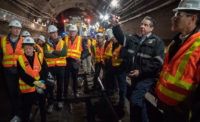Sean McGarvey, president of the Building and Construction Trades Dept. of the AFL-CIO, believes it is time for organized labor to rethink how the BCTD delivers its message to politicians and industry. The moment could be at hand, with Capitol Hill debating immigration and lingering concerns about nationwide construction jobs.
McGarvey warmed to the task during his keynote address at the Building Trades 2013 National Legislative Conference in Washington, D.C., on April 22-24.
During the 2012 election cycle, McGarvey claimed, the building trades—along with the carpenters and operating engineers—were the No. 1 "hard-dollar" contributor to political action committees. In addition to being the top cash contributor to Democratic Party PACs, he says the group was the fourth-highest contributor to the Republican Party.
McGarvey says those contributions reflect bipartisan efforts to reach politicians who will advocate for their issues. "We need to continue to foster our political independence so that we are inoculated against sudden shifts in the political winds," he said.
The building trades also are being more selective about offering financial support to candidates, waiting to see results before making contributions to candidates, McGarvey noted. "Those contributions don't amount to a hill of beans if we are not being strategic enough to generate returns on those investments," he said.
The building trades are reaching out to both parties on major initiatives such as the expansion of energy projects, particularly the Keystone XL Pipeline. Speaking at the event, Sen. John Hoven (R-N.D.) addressed the push for energy projects. Hoven, from a state dotted with new gas wells, said the pipeline could create 40,000 construction jobs.
For the building trades, immigration reform is among the most immediate and contentious issues on Capitol Hill. Although McGarvey says the building trades support portions of the proposed bill—such as a pathway to citizenship, penalties for employers who violate the law regarding illegal immigrant labor and strengthening U.S. borders— they are in solid opposition against efforts to create a new temporary-worker program.
Robbie Hunter, president of the State Building & Construction Trades Council of California, says a temporary-worker program runs the risk of undercutting wages and compromising labor conditions. "It's an opportunity for employers to bring in, essentially, slave labor," he says. "It allows an employer to say, 'If you don't do what we tell you under the conditions we tell you, you'll be sent home.' "
Regarding pension plans, McGarvey noted that the National Coordinating Committee for Multi-Employer Plans continues to work with contractors on a proposal it hopes will keep pension plans intact and solvent. "This proposal will serve as the basis for federal legislation that we will shepherd through the U.S. Congress until we reach final passage," he said. McGarvey stressed the need for public pension funds to invest in infrastructure, which would create job opportunities.
McGarvey also underscored the need for union locals and regional councils to reach out directly to employers to convey their message. In recent months, the BCTD has made a more concerted effort not to rely exclusively on contractors to discuss the possibility of using union labor on construction jobs. McGarvey said unions should also emphasize how their votes and political contributions can help kick-start projects and initiatives that benefit both employers and labor.
Tom Villanova, president of the Chicago and Cook County, Ill., building trades, says its council has worked directly with owners for more than two decades through tripartite agreements and that other councils need to do the same. "The days of relying on the contractor are over," Villanova said.


Post a comment to this article
Report Abusive Comment